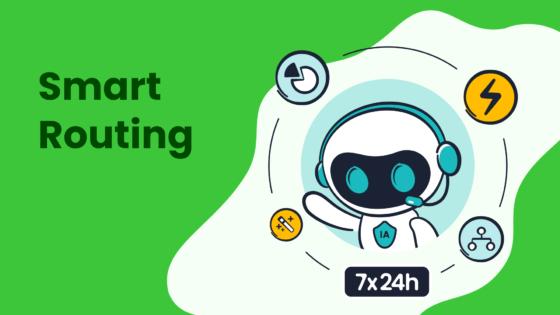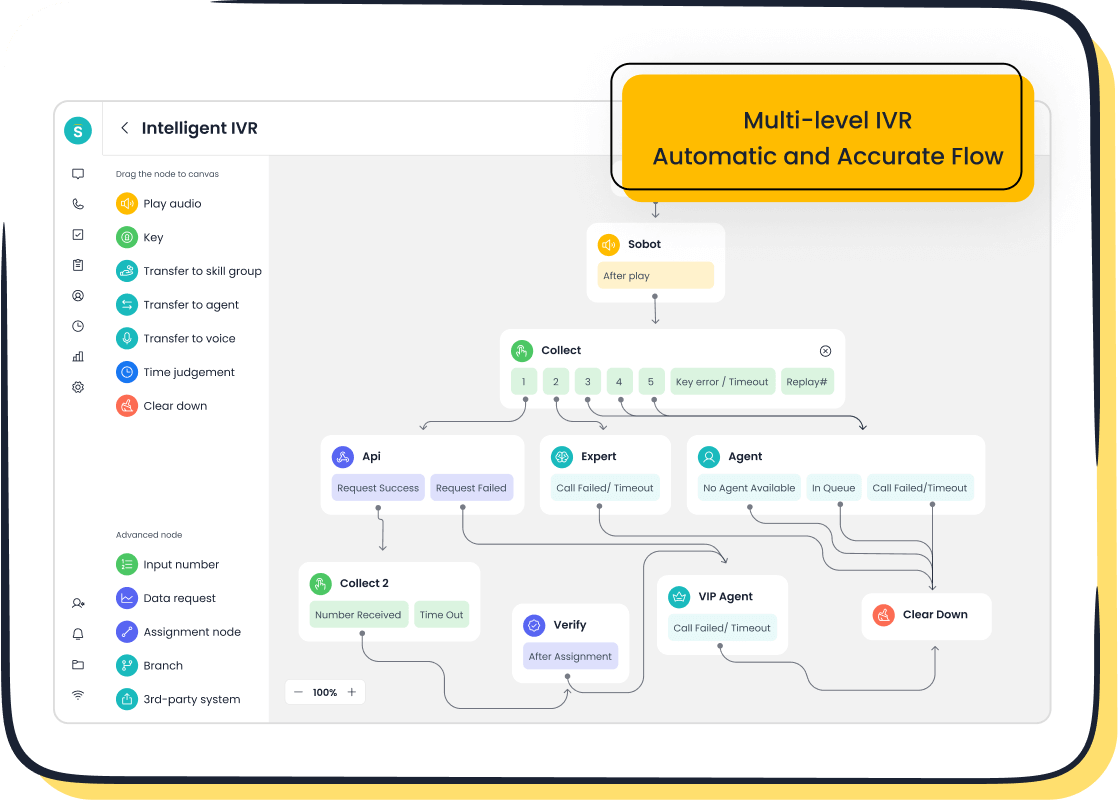5 Expert Tips for Choosing Customer Service Channels

If you want to get the best results when choosing customer service channels, start by looking at what works. Opay boosted its customer satisfaction score from 60% to 90% after using an omnichannel approach. Here’s a quick look at what customers prefer and how channel selection impacts satisfaction:
| Customer Service Channel | Preference/Usage Rate | Satisfaction/Impact Statistic |
|---|---|---|
| 93% | N/A | |
| Phone | 88% | N/A |
| Live Chat | 41% | N/A |
| Social Media | 34% | 65% of people aged 18-34 find it effective |
| Self-Service Portals | 72% | N/A |
| Chatbots | 55% | 78% of users still require human assistance |
| Omnichannel Customer Service | N/A | Companies have 23 times higher customer satisfaction rates |
Choosing customer service channels matters. You need to match your support to what your customers like. Sobot and Sobot AI offer unified tools, so you can deliver seamless support across every channel. Try these best practice tips and see how the right channel selection, including Sobot call center, can transform your service.
Know Your Customers

Customer Preferences
You can’t build a strong customer support strategy without knowing what your customers want. People have different needs based on their age, habits, and even where they live. If you want to pick the right customer service channels, you need to look at consumer preferences first.
- Customers under 25 love using social media for customer support.
- People over 55 usually pick up the phone and call for help.
- The 25-34 age group prefers email, but they also use mobile apps a lot.
- Email is a favorite customer communication channel for almost everyone.
- Millennials and Gen Z like social media and mobile apps best.
- Older adults stick with phone calls for customer support.
Call centers are still the top choice for many, especially older generations. Generation X likes call centers and electronic messaging, such as email or live chat. Generation Y prefers web self-service, chat, and SMS. Online chat is getting more popular every year. Self-service channels are growing, but call centers still handle the tough questions.
You also need to think about where your customers live. In Asia and the Americas, people want personal service and real human interaction. In the US and Europe, many prefer self-service options like chatbots or help articles. If you want to boost audience engagement, you should match your customer support to these cultural habits. Sobot’s omnichannel platform makes it easy to offer both personal and self-service support, so you can meet everyone’s needs.
Behavior Analysis
Understanding how your customers act helps you choose the best customer service channels. You can track what people do online and offline to see which customer communication channel works best for your business.
| Behavioral Data Type | Examples |
|---|---|
| Online Behavioral Data | Website clicks, searches, page visits, app usage, cart additions, order cancellations, email opens |
| Offline Behavioral Data | In-store purchases, call center conversations, event participation, loyalty program activity |
You can look at three main types of data:
- Registered data, like what you store in your CRM.
- Observed data, such as how users interact with your website or app.
- Voice of the consumer, which includes reviews and feedback online.
You might notice that customers spend more time on live chat or that they open emails but don’t reply. Maybe they start a purchase on your app but finish it in-store. These patterns help you decide which customer service channels to focus on for better customer support.
Sobot’s analytics tools let you track all these behaviors in one place. You can see which channels get the most use and which ones need improvement. This helps you deliver personalized customer experiences and improve your customer support strategy. When you know your customers, you can pick the right channels and make every interaction count.
Choosing Customer Service Channels with Sobot

Unified Platform
When you start choosing customer service channels, you want everything in one place. Sobot gives you a unified customer support platform that brings all your customer support channels together. You can handle phone calls, live chat, email, and even WhatsApp from a single dashboard. This makes it easy for your team to manage multi-channel support without jumping between different tools.
A unified customer support platform helps you avoid common mistakes, like missing messages or giving slow replies. You can see every customer conversation, no matter which customer communication channel they use. This means you never lose track of a request, and your team can respond faster. Sobot’s platform also lets you track which customer service channels your customers use most, so you can focus on what works best.
When you look at key factors for choosing customer service channels, you need to think about accessibility, reach, and how well each channel fits your customers. Sobot’s platform supports global phone numbers and works on mobile devices, so you can reach customers anywhere. You can also scale up as your business grows, making sure your multi-channel support keeps up with demand.
Omnichannel Integration
Omnichannel integration takes your customer support to the next level. With Sobot, you can connect all your customer support channels, so customers get a smooth experience. They can start a chat, switch to email, or call your team, and you always have their full history. This seamless flow keeps customers happy and saves your team time.
Let’s look at Opay. They used Sobot’s omnichannel solution to bring together social media, email, and voice support. After integrating their channels, Opay saw customer satisfaction jump from 60% to 90%. They also cut costs by 20% and boosted conversion rates by 17%. That’s the power of true multi-channel support.
Omnichannel integration also helps you automate routine tasks, like sorting tickets or routing calls. Your team can focus on complex issues, while Sobot handles the rest. You get better data, faster responses, and a more personal touch. When you choose the right customer service channels and connect them with Sobot, you set your business up for success.
Balance Automation and Human Touch
AI and Self-Service
You want your customer support to be fast and always available. That’s where AI and customer self-service come in. AI-powered tools, like chatbots and smart IVR systems, can answer simple questions, collect information, and guide customers through common problems. For example, Sobot’s AI chatbot can handle routine tasks, such as checking order status or resetting passwords, any time of day. This helps you reduce response times and lets your team focus on more complex issues.
Take a look at how different industries use AI for customer support:
| Industry / Organization | AI-Powered Self-Service Use Case | Key Benefits Achieved |
|---|---|---|
| Financial Services | Conversational AI for account queries | 40% IVR survey response rate |
| Healthcare | Virtual Agent answers 95% of calls | $100,000 saved yearly |
| Utilities | WhatsApp AI ticketing for repetitive questions | 48% more first-contact resolution |
| Banking | Voice biometrics and AI for banking support | 90% fewer agent calls |
| Public Services | AI chatbot for waste management | 80% query resolution, 24/7 support |
You can see that customer self-service works best when you have strong, up-to-date content. If your chatbot has access to clear FAQs and guides, it can solve many problems without help from a person. This means your customer support team can spend more time on tricky questions. Sobot’s platform makes it easy to update your help content and track which questions come up most.
Live Agent Support
Sometimes, you need a real person. Live agents shine when customers have complicated problems or feel upset. In fact, 86% of people say they prefer talking to a real person for customer support, especially when things get tough. Live chat is a favorite, with satisfaction rates as high as 86%. When you offer live chat, you make it easy for customers to get help fast—average wait times are just 36 seconds.
Tip: Customers who use live chat before buying are 48% more likely to complete their purchase.
Your customer support team brings empathy and creative thinking to every conversation. They can ask follow-up questions, understand feelings, and build trust. Sobot’s unified workspace gives agents all the info they need, so they can help customers quickly and personally. When you combine AI for simple tasks and live agents for complex ones, you create a customer support experience that feels both smart and human.
Channel Optimization for Efficiency
You want your customer service to run smoothly and get better over time. That’s where channel optimization comes in. When you use the right tools and track the right numbers, you can make every customer interaction count. Sobot’s analytics and monitoring tools help you see what’s working and what needs to change. You can spot trends, fix problems fast, and keep your team focused on what matters most.
Performance Tracking
Tracking how your customer support channels perform is key to channel optimization. You need to know which channels your customers use most and how well each one works. Sobot gives you dashboards that show real-time data, so you can see things like response times, ticket volume, and customer satisfaction scores. This helps you make smart choices and improve your service.
Here are some important metrics you should watch:
| Metric Name | Description |
|---|---|
| Customer Satisfaction Score (CSAT) | Measures how happy customers are after support. |
| Net Promoter Score (NPS) | Shows if customers would recommend your business. |
| Customer Effort Score (CES) | Tells you how easy it is for customers to get help. |
| First Response Time (FRT) | Tracks how fast your team replies to new tickets. |
| First Contact Resolution (FCR) | Measures how often you solve issues on the first try. |
| Average Handle Time (AHT) | Shows how long each support interaction takes. |
| Ticket Volume by Channel | Counts how many requests come in through each channel. |
When you track these numbers, you can see where you shine and where you need to improve. For example, if your first response time is slow on live chat, you can add more agents or use automation to speed things up. Companies that use real-time analytics see a 15% boost in efficiency and customer satisfaction (Forrester). That’s a big win for customer service optimization.
Resource Allocation
Channel optimization also means putting your people and tools where they do the most good. You don’t need to be everywhere—just where your customers want you. Sobot’s unified platform lets you manage all your customer support channels in one place. This makes it easy to see which channels need more help and which ones can run with less.
Here are some best practices for resource allocation:
- Manage all your channels from a single platform to avoid confusion and save money.
- Use data to see which channels your customers like best. Focus your team there.
- Let AI and automation handle simple tasks. This frees up your agents for tough problems.
- Give your team access to customer history and feedback, so they can help faster.
When you use Sobot’s analytics, you can spot patterns and adjust your resources quickly. For example, if you see more tickets coming in through WhatsApp, you can move agents to that channel. This kind of channel optimization helps you deliver better multi-channel support and keeps your team working efficiently.
Tip: Companies that use feedback loops and real-time data can increase customer retention by 13% (SurveyMonkey). Keep listening and adjusting for the best results.
Channel optimization is not a one-time job. You need to keep tracking, testing, and improving. Sobot makes it easy to optimize customer service and reach your goals for customer service optimization. When you use data to guide your choices, you build a support team that’s ready for anything.
Continuous Improvement in Customer Support
Feedback Loops
You can’t improve your customer support if you don’t listen to your customers. Feedback loops help you spot what’s working and what needs to change. Leading companies use many ways to collect feedback, like:
- Email, website, and in-app surveys right after a support chat or call
- SMS surveys and feedback forms for quick responses
- Social media listening and online reviews to catch real opinions
- Analyzing support chats and emails for trends
- Customer interviews and focus groups for deeper insights
Short, simple surveys get more answers. If you personalize the feedback request, people feel heard and want to share. Sobot makes it easy to gather feedback from every channel, so you never miss a chance to learn. When you act on feedback and tell customers what changed, you build trust and boost customer retention.
Top brands don’t just collect feedback—they use it. They share insights with every team, fix simple issues fast, and keep customers in the loop. You can track your progress with metrics like CSAT, NPS, and CES. This is a big part of channel optimization because it shows you where to focus your efforts.
Tip: Always close the loop by letting customers know how their feedback made a difference. This turns feedback into real channel optimization.
Adapting to Change
Customer needs change fast. You need to keep up if you want to deliver a great customer experience. Companies like Netflix lead the way by watching trends, listening to feedback, and changing their support channels as needed. You can do the same by:
- Using analytics tools to track what customers want
- Watching competitors and industry news for new ideas
- Training your team to handle new channels and tools
- Testing new support options, like chatbots or WhatsApp, and seeing what works
Sobot’s omnichannel platform helps you adapt quickly. You can add new channels, update workflows, and use real-time data for channel optimization. This keeps your support team ready for anything. Challenges will pop up—like managing more channels or meeting higher expectations—but with the right tools, you can turn change into an advantage.
Channel optimization is not a one-time job. You need to keep learning, testing, and improving. This mindset helps you stay ahead and keeps your customer experience strong.
You now have five expert tips to help you choose the best customer service channels. Here’s what you gain:
- Manage multi-channel support with a unified platform like Sobot.
- Reduce response times and make switching between channels easy for your customers.
- Use data and automation to boost satisfaction and lower costs.
- Personalize every interaction for better results.
- Keep improving by tracking feedback and training your team.
Take a moment to audit your current channels. Try Sobot’s all-in-one solution to see real improvements in customer satisfaction and efficiency. Remember, ongoing channel optimization and customer-centric support drive long-term growth and loyalty. 🚀
FAQ
What are the most popular customer service channels today?
You see customers using email, phone, live chat, and social media the most. According to Salesforce, 93% of people still use email for support. Many also like self-service portals and chatbots. Sobot lets you manage all these customer service channels in one place.
How do I know which customer service channels my customers prefer?
You can check your analytics to see which customer communication channel gets the most use. Sobot’s dashboard shows you real-time data. You can also ask customers directly with a quick survey or feedback form.
Why is multi-channel support important for my business?
Multi-channel support helps you reach customers where they feel comfortable. Some people want to chat, while others prefer a phone call. When you offer more customer service channels, you boost satisfaction and build loyalty. Sobot’s unified platform makes this easy.
How does channel optimization improve customer support?
Channel optimization means you use data to make each customer service channel work better. You can spot slow response times or busy channels. Sobot’s analytics help you adjust quickly. This leads to faster replies and happier customers.
Can I add or remove customer service channels as my business grows?
Yes! You can add new customer service channels or remove ones that don’t work. Sobot’s platform lets you scale up or down anytime. This keeps your customer support flexible and ready for change.
See Also
Top Strategies For Selecting Social Media Support Tools
Effective Ways To Improve Live Chat Customer Experience
How To Successfully Deploy Omnichannel Contact Center Systems
